Altered ultrasonic vocalizations in a tuberous sclerosis mouse model of autism
- PMID: 20534473
- PMCID: PMC2890736
- DOI: 10.1073/pnas.1005620107
Altered ultrasonic vocalizations in a tuberous sclerosis mouse model of autism
Abstract
Tuberous sclerosis (TSC) is an autosomally dominant neurocutaneous disease notable for its high comorbidity with autism in human patients. Studies of murine models of tuberous sclerosis have found defects in cognition and learning, but thus far have not uncovered deficits in social behaviors relevant to autism. To explore social communication and interaction in TSC2 heterozygous mice, we recorded ultrasonic vocalizations (USV) and found that although both wild-type (WT) and heterozygous pups born to WT dams showed similar call rates and patterns, baseline vocalization rates were elevated in pups born to heterozygous dams. Further analysis revealed several robust features of maternal potentiation in all but WT pups born to heterozygous dams. This lack of potentiation is suggestive of defects in mother-pup social interaction during or before the reunion period between WT pups and heterozygous dams. Intriguingly, male pups of both genotypes born to heterozygous dams showed particularly heightened call rates and burst patterns. Because our maternal retrieval experiments revealed that TSC2(+/-) dams exhibited improved defensive reactions against intruders and highly efficient pup retrieval performance, the alterations in their pups' USVs and maternal potentiation do not appear to result from poor maternal care. These findings suggest that a pup's interaction with its mother strongly influences the pup's vocal communication, revealing an intriguing dependence of this social behavior on TSC2 gene dosage of both parties involved. Our study of this murine model thus uncovers social abnormalities that arise from TSC haploinsufficiency and are suggestive of autism.
Conflict of interest statement
The authors declare no conflict of interest.
Figures
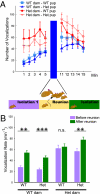
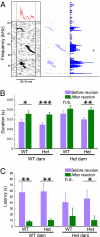
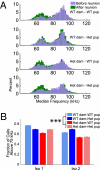
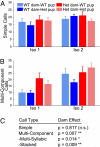
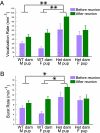
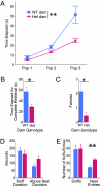
Similar articles
-
Sex-specific modulation of early life vocalization and cognition by Fmr1 gene dosage in a mouse model of Fragile X Syndrome.Biol Sex Differ. 2024 Feb 21;15(1):18. doi: 10.1186/s13293-024-00594-3. Biol Sex Differ. 2024. PMID: 38383408 Free PMC article.
-
Alterations in the ultrasonic vocalization sequences in pups of an autism spectrum disorder mouse model: A longitudinal study over age and sex.Prog Neuropsychopharmacol Biol Psychiatry. 2025 Jun 20;139:111372. doi: 10.1016/j.pnpbp.2025.111372. Epub 2025 Apr 22. Prog Neuropsychopharmacol Biol Psychiatry. 2025. PMID: 40274253
-
Dopamine receptor D2 deficiency reduces mouse pup ultrasonic vocalizations and maternal responsiveness.Genes Brain Behav. 2013 Jun;12(4):397-404. doi: 10.1111/gbb.12037. Epub 2013 Apr 15. Genes Brain Behav. 2013. PMID: 23521753
-
Ultrasonic vocalizations: a tool for behavioural phenotyping of mouse models of neurodevelopmental disorders.Neurosci Biobehav Rev. 2009 Apr;33(4):508-15. doi: 10.1016/j.neubiorev.2008.08.003. Epub 2008 Aug 13. Neurosci Biobehav Rev. 2009. PMID: 18771687 Free PMC article. Review.
-
Acquisition and expression of a socially mediated separation response.Behav Brain Res. 2007 Sep 4;182(2):180-92. doi: 10.1016/j.bbr.2007.02.016. Epub 2007 Feb 20. Behav Brain Res. 2007. PMID: 17379325 Free PMC article. Review.
Cited by
-
Assessment of the effects of sex, age, and rearing condition on ultrasonic vocalizations elicited by pups during the maternal potentiation paradigm in C57BL/6J mice.Dev Psychobiol. 2022 Dec;64(8):e22341. doi: 10.1002/dev.22341. Dev Psychobiol. 2022. PMID: 36426792 Free PMC article.
-
The Connectivity Fingerprint of the Fusiform Gyrus Captures the Risk of Developing Autism in Infants with Tuberous Sclerosis Complex.Cereb Cortex. 2020 Apr 14;30(4):2199-2214. doi: 10.1093/cercor/bhz233. Cereb Cortex. 2020. PMID: 31812987 Free PMC article.
-
Evaluation of Pax6 mutant rat as a model for autism.PLoS One. 2010 Dec 21;5(12):e15500. doi: 10.1371/journal.pone.0015500. PLoS One. 2010. PMID: 21203536 Free PMC article.
-
Sociosexual and communication deficits after traumatic injury to the developing murine brain.PLoS One. 2014 Aug 8;9(8):e103386. doi: 10.1371/journal.pone.0103386. eCollection 2014. PLoS One. 2014. PMID: 25106033 Free PMC article.
-
Clinical and Neurobiological Relevance of Current Animal Models of Autism Spectrum Disorders.Biomol Ther (Seoul). 2016 May 1;24(3):207-43. doi: 10.4062/biomolther.2016.061. Biomol Ther (Seoul). 2016. PMID: 27133257 Free PMC article. Review.
References
-
- Curatolo P, Porfirio MC, Manzi B, Seri S. Autism in tuberous sclerosis. Eur J Paediatr Neurol. 2004;8:327–332. - PubMed
-
- Moy SS, Nadler JJ. Advances in behavioral genetics: Mouse models of autism. Mol Psychiatry. 2008;13:4–26. - PubMed
-
- Jaworski J, Sheng M. The growing role of mTOR in neuronal development and plasticity. Mol Neurobiol. 2006;34:205–219. - PubMed
-
- Wullschleger S, Loewith R, Hall MN. TOR signaling in growth and metabolism. Cell. 2006;124:471–484. - PubMed
Publication types
MeSH terms
Substances
Grants and funding
LinkOut - more resources
Full Text Sources
Medical
Molecular Biology Databases
Miscellaneous

